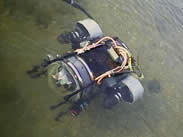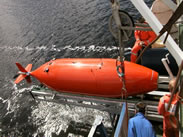About AUVs
With the explosion and combination of the mechanical engineering, electrical engineering and computer science fields, the birth of mechatronics has led to extensive research and development in the area of mobile robotics.
Though terrestrial robotics is a field of highly active research and commonly increasing applications, underwater robotic technologies have not grown at the same rate, partially owing to the high costs associated with the development of such robots. Underwater robotic technologies are divided into two basic groups:
-
 Remotely Operated Vehicles (ROVs)
As the name suggest, these vehicles are remotely operated by a highly skilled and trained human operator. Due to rapid failure of remote communication technologies underwater, in order to allow for remote control, these vehicles are physically connected over a tether cable to a remote operation unit. These vehicles greatly improve efficiency of all kinds of underwater operations by removing the requirement of human presence inside the submersible. Being remotely operated these vehicles can also be deployed in missions which pose a great risk to human life. ROVs provide many advantages in a multitude of applications, some of which have been commonly seen in popular Hollywood movies such as Abyss. ROVs gained quick popularity because of their coft-effectiveness and high mission applicability, but with all their advantages the tether cable adds a huge disadvantage in terms of mission duration and range. Moreover, the presence of a human operator leaves possibility of errors in critical missions.
-
 Autonomous Underwater Vehicles (AUVs)
AUVs are a relatively new development in underwater robotics technologies and are an area of active and vigorous research. These vehicles are completely autonomous and do not require any human control in order to perform the task at hand. These vehicles carry a plethora of sensors on board and are able to accurately collect, store, process and transmit data without the necessity of a communicaitons or control tether to link it with any control unit. This ability to operate free of any tether cables increases the efficiency and cost-effectiveness of these vehicles by enhancing their mission duration and range capabilities while also increasing their speeds compared to ROVs. Also, due to onboard cutting edge comupter vision and image processing technologies and presence of intelligent navigation systems, these vehicles are able to cut down the number of errors in critical missions with the elimination of a human operator.
Both these underwater robotics technologies have found many commercial, scientific, defence and academic applicaitons. As the research in this field increases and other innovations are introduced into the operations of unmanned underwater vehicles (UUVs), AUVs will become increasingly more common and highly cost effective.
AUVs have not been extensively adopted in the developing countries, when compared to the developed nations of the west, leaving a big market for these vehicles in over half of the world. The basic reason behind the low adoption rate is the high maintainance, manufacturing, development and research costs associated with AUVs. New research however is reducing the costs associated with AUVs and this should enable the developing nations also to make strides in contributing to the development of this technology.
Advantages of AUVs
- Long term economic benefits owing to dramatic improvement in data quality.
- Optimum positioning of the sensors allows the AUV to follow a rough terrain effortlessly.
- Not being tied down to any surface the AUV becomes a highly stable and agile platform with high deep-water cruising speeds.
- Being able to move freely, these systems have lower turning radius (in the order of a few meters) and also the ablity to spin around a single axis.
- Excellent navigational algorithms using computational intelligence technolgies provide for accurate target location and superior guidance of the submersible.
- Deployment costs are much lower since these vehicles do not have any bulky and complex support equipment requirements.
- Being able to harbour multiple systems at the same time, AUVs provide higher reliability by being able to carry backup systems without extra deployment costs.
- By elimination of line turns associated with ROVs, the AUVs are able to provide a much higher time and cost efficiency.
- Elimination of the human operator reduces errors associated with operational mistakes and also the high costs that come in employing a highly skilled robot operator.
Applications of AUVs
- Academic
- Research.
- Development.
- Teaching.
- Practical applications.
- Projects.
- Defence
- Reconnaissance.
- Monitoring.
- Detection.
- Surveillance.
- Customs
- Underwater power lines
- Line laying.
- Line monitoring
- Delivery Systems
- Telecommunications
|
- Geological Survey
- Earthquake detection and monitoring.
- Tsunami detection.
- Volcano monitoring.
- Salinity monitoring.
- Seabed and deep sea exploration.
- Oil and Gas Industry
- Seabed survey.
- Pipeline monitoring.
- Intervention.
- Iceberg reconnaissance.
- Marine Science Research
- Marine Biology Research
- Oceanography Studies
- Shipwreck Reconnaissance
- Fisheries
- Repair and Rescue
|
|